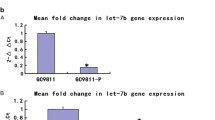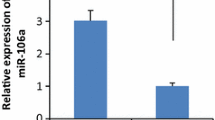Abstract
Dysregulation of specific microRNAs (miRNAs) is found to play a vital role in carcinogenesis and progression of gastric cancer (GC). In the present study, we investigated the expression profiles of miRNAs in gastric cancer. Let-7b was found downregulated remarkably in gastric cancer tissues and was correlated with Helicobacter pylori infection, tumor stage, and lymphatic metastasis. Ectopic expression of let-7b suppressed the growth, migration, invasion, and tumorigenicity of GC cells, whereas let-7b knockdown promoted these phenotypes. Bioinformatic analysis predicted collagen triple helix repeat containing 1 (Cthrc1) as a direct target of let-7b. Luciferase assay showed that let-7b repressed the activity of Cthrc1 through binding its 3’UTR. Western blotting also confirmed that the protein levels of Cthrc1 were decreased by let-7b. Cthrc1 was significantly upregulated and reversely correlated with let-7b levels in GC. Co-expression of let-7b and Cthrc1 without its 3’UTR could rescue cell growth, migration, and invasion inhibited by let-7b. These results suggest that let-7b may directly target Cthrc1 and function as a tumor suppressor gene in GC.




Similar content being viewed by others
References
Ferlay J, Shin HR, Bray F, et al. Estimates of worldwide burden of cancer in 2008: GLOBOCAN 2008. Int J Cancer. 2010;127:2893–917.
Zeng H, Zheng R, Guo Y, et al. Cancer survival in China, 2003–2005: a population-based study. Int J Cancer. 2014. doi:10.1002/ijc.29227.
Sheridan C. Gene therapy finds its niche. 2011;29:121–8.
D’Angelo G, Di Rienzo T, Ojetti V. Microarray analysis in gastric cancer: a review. World J Gastroenterol. 2014;20:11972–6.
Garajová I, Le Large TY, Frampton AE, et al. Molecular mechanisms underlying the role of microRNAs in the chemoresistance of pancreatic cancer. Biomed Res Int. 2014;2014:678401.
Wang H, Yuan X, Zhou Z, et al. MicroRNAs might be promising biomarkers of human gliomas. Asian Pac J Cancer Prev. 2011;12:833–5.
Xiao L, Wang JY. RNA-binding proteins and microRNAs in gastrointestinal epithelial homeostasis and diseases. Curr Opin Pharmacol. 2014;19C:46–53.
Reinhart BJ, Slack FJ, Basson M, et al. The 21-nucleotide let-7 RNA regulates developmental timing in Caenorhabditis elegans. Nature. 2000;403:901–6.
Ruby JG, Jan C, Player C, et al. Large-scale sequencing reveals 21U-RNAs and additional microRNAs and endogenous siRNAs in C. elegans. Cell. 2006;127:1193–207.
Lawrie CH, Chi J, Taylor S, et al. Expression of microRNAs in diffuse large B cell lymphoma is associated with immunophenotype, survival and transformation from follicular lymphoma. J Cell Mol Med. 2009;13:1248–60.
Xiang KM, Li XR. MiR-133b acts as a tumor suppressor and negatively regulates TBPL1 in colorectal cancer cells. Asian Pac J Cancer Prev. 2014;15:3767–72.
Song CQ, Zhang JH, Shi JC, et al. Bioinformatic prediction of SNPs within miRNA binding sites of inflammatory genes associated with gastric cancer. Asian Pac J Cancer Prev. 2014;15:937–43.
Sharma SB, Lin CC, Farrugia MK, et al. microRNAs-206 and -21 cooperate to promote RAS-ERK signaling by suppressing the translation of RASA1 and SPRED1. Mol Cell Biol. 2014
Tahara T, Okubo M, Shibata T, et al. Association between common genetic variants in pre-microRNAs and prognosis of advanced gastric cancer treated with chemotherapy. Anticancer Res. 2014;34:5199–204.
Martínez-Pacheco M, Hidalgo-Miranda A, Romero-Córdoba S, et al. MRNA and miRNA expression patterns associated to pathways linked to metal mixture health effects. Gene. 2014;533:508–14.
Qin S, Ai F, Ji WF, et al. miR-19a promotes cell growth and tumorigenesis through targeting SOCS1 in gastric cancer. Asian Pac J Cancer Prev. 2013;14:835–40.
Xu L, Dai WQ, Xu XF, et al. Effects of multiple-target anti-microRNA antisense oligodeoxyribonucleotides on proliferation and migration of gastric cancer cells. Asian Pac J Cancer Prev. 2012;13:3203–7.
Tong F, Cao P, Yin Y, et al. MicroRNAs in gastric cancer: from benchtop to bedside. Dig Dis Sci. 2014;59:24–30.
González CA, Sala N, Rokkas T. Gastric cancer: epidemiologic aspects. Helicobacter. 2013;18:34–8.
Wang JL, Hu Y, Kong X, et al. Candidate microRNA biomarkers in human gastric cancer: a systematic review and validation study. PLoS One. 2013;8:e73683.
Shimizu S, Takehara T, Hikita H, et al. The let-7 family of microRNAs inhibits Bcl-xL expression and potentiates sorafenib-induced apoptosis in human hepatocellular carcinoma. J Hepatol. 2010;52:698–704.
Kumar MS, Erkeland SJ, Pester RE, et al. Suppression of non-small cell lung tumor development by the let-7 microRNA family. Proc Natl Acad Sci U S A. 2008;105:3903–8.
Lu J, Getz G, Miska EA, et al. MicroRNA expression profiles classify human cancers. Nature. 2005;435:834–8.
Pasquinelli AE, Reinhart BJ, Slack F, et al. Conservation of the sequence and temporal expression of let-7 heterochronic regulatory RNA. Nature. 2000;408:86–9.
Kim HC, Kim YS, Oh HW, et al. Collagen triple helix repeat containing 1 (CTHRC1) acts via ERK-dependent induction of MMP9 to promote invasion of colorectal cancer cells. Oncotarget. 2014;5:519–29.
Gu L, Liu L, Zhong L, et al. Cthrc1 overexpression is an independent prognostic marker in gastric cancer. Hum Pathol. 2014;45:1031–8.
Pyagay P, Heroult M, Wang Q, et al. Collagen triple helix repeat containing 1, a novel secreted protein in injured and diseased arteries, inhibits collagen expression and promotes cell migration. Circ Res. 2005;96:261–8.
Tang L, Dai DL, Su M, et al. Aberrant expression of collagen triple helix repeat containing 1 in human solid cancers. Clin Cancer Res. 2006;12:3716–22.
Park EH, Kim S, Jo JY, et al. Collagen triple helix repeat containing-1 promotes pancreatic cancer progression by regulating migration and adhesion of tumor cells. Carcinogenesis. 2013;34:694–702.
Palma M, Lopez L, García M, et al. Detection of collagen triple helix repeat containing-1 and nuclear factor (erythroid-derived 2)-like 3 in colorectal cancer. BMC Clin Pathol. 2012;12:2.
Kharaishvili G, Cizkova M, Bouchalova K, et al. Collagen triple helix repeat containing 1 protein, periostin and versican in primary and metastatic breast cancer: an immunohistochemical study. J Clin Pathol. 2011;64:977–82.
Tan F, Liu F, Liu H, et al. CTHRC1 is associated with peritoneal carcinomatosis in colorectal cancer: a new predictor for prognosis. Med Oncol. 2013;30:473.
Acknowledgments
This work was supported by the National Natural Science Foundation of China (No.812111519 and No.81272712) and the Project Funded by the Priority Academic Program Development of Jiangsu Higher Education Institutions (JX10231801).
Conflicts of interests
None
Author information
Authors and Affiliations
Corresponding author
Additional information
Junbo Yu and Jin Feng contributed equally to this work.
Rights and permissions
About this article
Cite this article
Yu, J., Feng, J., Zhi, X. et al. Let-7b inhibits cell proliferation, migration, and invasion through targeting Cthrc1 in gastric cancer. Tumor Biol. 36, 3221–3229 (2015). https://doi.org/10.1007/s13277-014-2950-5
Received:
Accepted:
Published:
Issue Date:
DOI: https://doi.org/10.1007/s13277-014-2950-5




